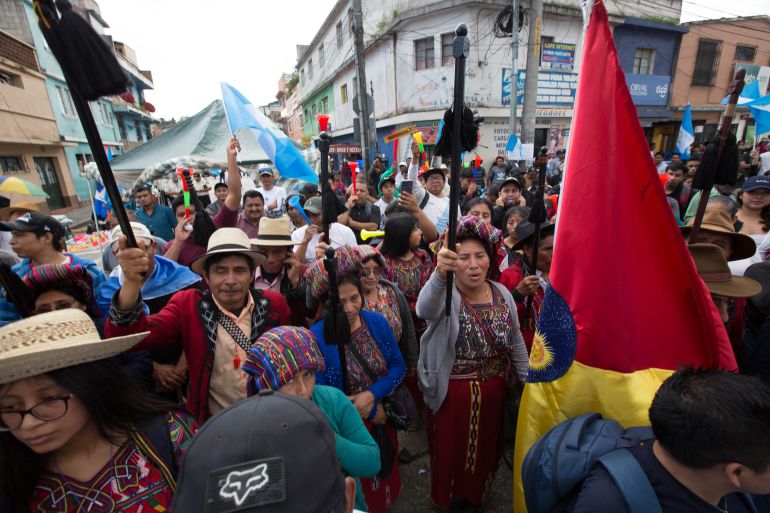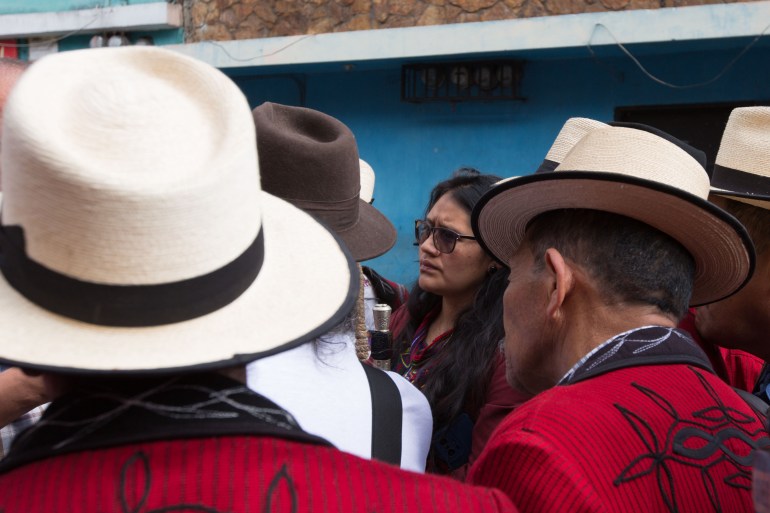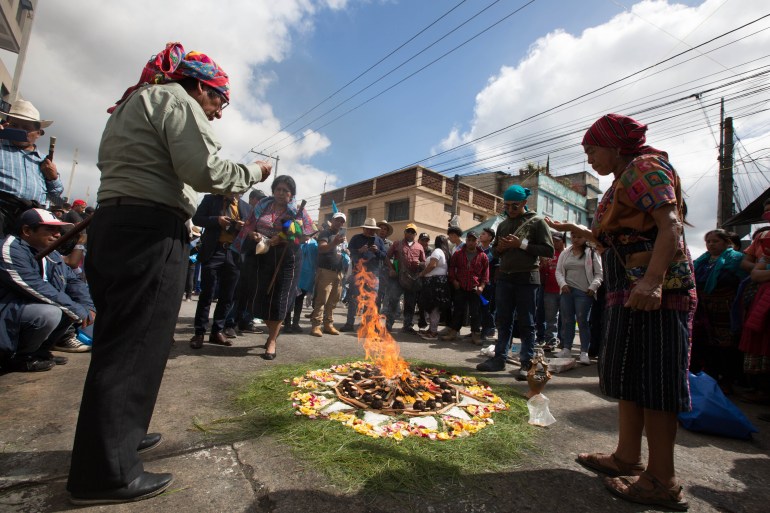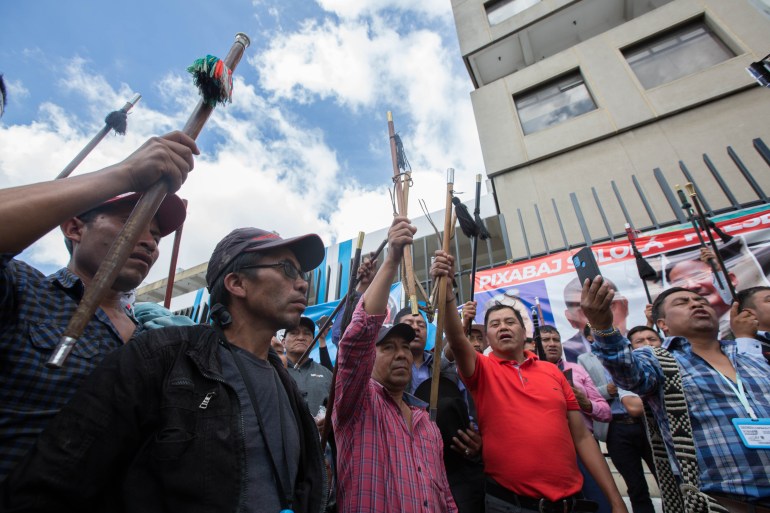Guatemala’s Indigenous leaders take to the streets in nationwide protests
The protests come in response to alleged interference in the election victory of anticorruption candidate Bernardo Arevalo.

Guatemala City, Guatemala – Every day, they gather at the gates of the public prosecutor’s office: Indigenous leaders, protesting against threats to Guatemala’s election integrity.
These leaders — some of whom dress in brightly embroidered huipil blouses and ceremonial attire — have become the face of the demonstrations that have exploded across the Central American country in recent weeks.
Keep reading
list of 3 itemsGuatemalan justice ‘being used politically’ against president-elect: OAS
Guatemala’s crisis deepens amid new raids, suspended gov’t transition
Since October 2, as many as 140 roadways have been blocked, and thousands of people have flooded the streets of the capital, Guatemala City, to demand accountability for efforts they say are designed to subvert the country’s recent presidential elections.
SitPo’p Herrera, 32, is one of those Indigenous leaders. A member of the Ixil Mayan Ancestral Authority, an autonomous Indigenous government, she travelled 226km (140 miles) from her highland town of Nebaj to arrive in Guatemala City on October 4, where she had been demonstrating ever since.
Herrera said she was there to represent Ixil Mayan communities in the protests. She and other Indigenous leaders have maintained a near-constant presence outside the prosecutor’s office, holding ceremonies and leading chants.

They call for the resignation of Attorney General Maria Consuelo Porras and other political figures involved in raiding the country’s electoral authority and targeting the campaign of Bernardo Arevalo, the dark-horse candidate elected president on August 20.
Critics fear the raids — five of which have been conducted since the elections — could threaten the results and throw Guatemala’s democracy into turmoil.
A short woman with a youthful face and a shy but confident smile, Herrera holds the attorney general responsible for the situation, which has seen confidential voter material breached.
“This is a response to their provocations,” Herrera said of the sprawling protests unfolding around her. Frustrated with government corruption and organised crime in Guatemala, she felt there was little choice but to demonstrate.
“The people have been patient, but this is the only way the people have — to go out into the streets so that their voices can be heard,” she said.
The encampment outside the public prosecutor’s office is part of a larger nationwide protest movement launched on October 2. Groups like the 48 Cantones of Totonicapan, an Indigenous community government based in the west-central highlands, have taken a leading role in organising the protests.
Mayan spiritual guides, for instance, hold fire ceremonies outside the office’s entrance: They believe the swirling flames will elevate their calls for justice.

But as the protests stretch on, tensions have risen. On Monday, Attorney General Porras — whom the United States accused of “significant corruption” — called the demonstrations “illegal actions”.
Outgoing President Alejandro Giammattei echoed her accusations later in the day, suggesting the protesters had “received support and advice” from foreign interests. He said he would seek arrest warrants for those involved in the blockades.
Indigenous groups, including the 48 Cantones of Totonicapan, previously declared Giammattei a “persona non grata”, after he was accused of showing disrespect during a 2020 visit with the Kaqchikel people of San Juan Comalapa.
Still, the Indigenous activism underpinning many of the protests stems from a much broader history of discord with the Guatemalan government, according to Herrera.
“There has not been any good relationship with the government,” she said. “They do not act in favour of the people, of us.”
Herrera was appointed to serve her community Tzalba in 2017. Her position was unpaid. At first, she did not feel qualified to take on a leadership role, but she finally accepted, becoming one of the youngest women ever to serve on the Ixil Mayan Ancestral Authority.
In 2022, she became the first woman to be appointed the Indigenous mayor of Nebaj, a town with a population of over 72,000 people, a majority of whom are Ixil Mayan.

Indigenous people make up almost half of Guatemala’s population, according to government statistics. That gives it the second-highest percentage of Indigenous citizens in Latin America, behind Bolivia.
But Guatemala has historically underrepresented its Indigenous population in politics: Academics estimate that Indigenous peoples have never held more than 10 percent of the seats in the national congress.
And poverty among their communities is high. The United Nations estimates that 79 percent of Indigenous people qualify as poor, a rate 30 percent higher than the national average.
Critics have blamed government policies for amplifying that wealth inequality. A 2015 study from the Central American Institute for Fiscal Studies (ICEFI), a Guatemala City-based think tank, found that for every dollar that the national government invested in non-Indigenous communities, only 45 cents were spent on Indigenous areas.
The result, observers say, has been a lack of public works in Indigenous-majority regions: Schools are underfunded, hospitals lack medicine and roads are in disrepair.
“Most of the Indigenous population lives in the departments where they live in poverty, fighting for their own,” Herrera said. “We talk about the development of a democratic state, but no, it has not fulfilled its duties.”

Part of this marginalisation arises from a history of government violence. Guatemala endured a bloody civil war that lasted 36 years, and by its conclusion in 1996, the UN estimated 200,000 had died — more than 80 percent of them from Indigenous Mayan communities.
One of the country’s leaders during that time, dictator Efrain Rios Montt, was ultimately convicted of genocide and crimes against humanity. His daughter Zury Rios was a candidate in the most recent presidential race.
Critics say Indigenous leaders have since continued to face violence and intimidation in Guatemala’s political system.
For instance, when the Indigenous human rights advocate Thelma Cabrera ran for the presidency this year, her campaign generated early momentum — only to be cut short when a court disqualified her over a paperwork issue with her running mate.
President-elect Arevalo, who campaigned on an anticorruption platform, has likewise faced court orders seeking to suspend his political party. The Organization of American States has warned that the “mechanisms and tools of Guatemalan justice are being used politically” against candidates like Arevalo.
He won the presidency with 60 percent of the vote, upsetting traditional establishment candidates including former First Lady Sandra Torres.
Edgar Ortiz, a constitutional lawyer, believes the court orders against Arevalo’s party are part of a scheme to make unfounded allegations of election fraud. He and other lawyers have filed a complaint with Guatemala’s Constitutional Court to protest the office’s actions as anti-democratic.
“They aim to sow doubts about these elections,” Ortiz said of the prosecutors. “Their agenda is to prevent Arevalo from taking office in January.”
The threat to Arevalo’s election victory has mobilised many in the Guatemalan electorate. Virginia Obispo, a 23-year-old grade school teacher from Mixco, came to Guatemala City to bring the protesters free food and water.
“We are raising our voice with the 48 Cantones,” she said, referencing the Indigenous community governments behind the rallies. “We know that, with all [of us] together, we are going to make a change. We want to get rid of all those people in the government who are corrupt.”
As for Herrera, she hopes the protests will result in the election mandate being upheld.
“We want it to be fulfilled and for there to be a true democracy, to live in harmony,” Herrera said. “So that we all have the same rights.”
As she moves through the crowds, she carries in her hands a vara, a 76-centimetre staff adorned with engravings that symbolise authority in Guatemala’s Indigenous communities.
“Corruption is what unites us here,” Herrera said. “Not only Indigenous peoples but the entire population of Guatemala.”